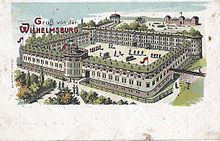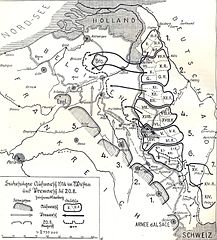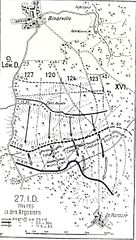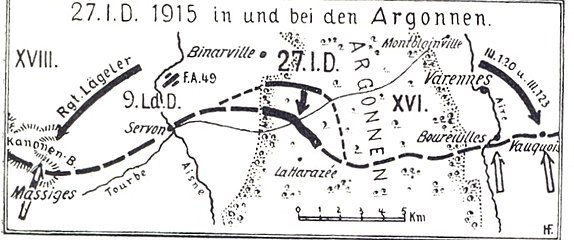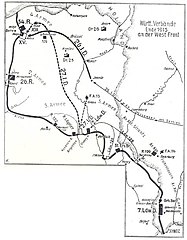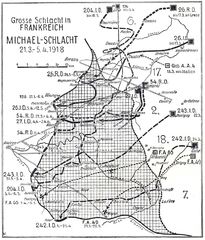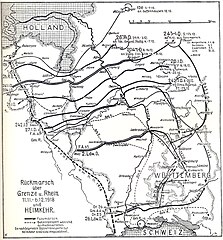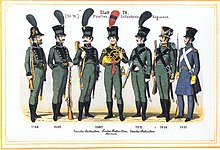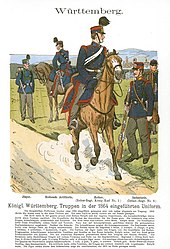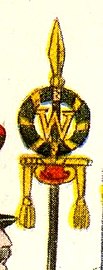Grenadier Regiment "King Karl" (5th Württembergisches) No. 123
|
Grenadier Regiment "King Karl" (5th Württembergisches) No. 123 |
|
|---|---|
| active | 1806 to 1919 |
| Country |
|
| Armed forces | German Army / Württemberg Army |
| Branch of service | infantry |
| Type | Infantry Regiment |
| structure | See outline |
| Insinuation | XIII. (Royal Württemberg) Army Corps |
| Location | See garrisons |
| march | Presentation march: "March King Friedrich Wilhelm III" AM I, 1a) Parade march: "King Karl March" |
| management | |
| Commanders | See list of commanders |
The grenadier regiment "King Karl" (5th Württembergisches) No. 123 was from 1813 to 1919 a regiment of the Württemberg army .
history
Surname
On February 3, 1813, the regiment was initially set up with only one battalion from the remains of the foot-hunter battalion No. 1 König , in November of the same year (after the losses in the campaign against Prussia, see below) the regiment was formed with two Battalions re-established. On June 4, 1814, it was renamed the King Foothunter Regiment No. 9 . With the military reform of 1817, the regiment was reinforced by two companies of the dissolved light infantry regiment No. 11 and was called from March 31, 1817 in the 5th Infantry Regiment and from December 19, 1864 after its chief 5th Infantry Regiment King Karl .
After the military convention with the North German Confederation of 21./25. On November 2, 1870, like all Wuerttemberg troops to distinguish it from troops from other German states, it received the corresponding addition 5th Württemberg Infantry Regiment (Grenadier Regiment) King Karl . On December 18, 1871, all Württemberg regiments received additional numbers. These corresponded to the consecutive numbering of all regiments of the German Armed Forces, regardless of their affiliation to one of the contingents, the regiment was given the number 123: 5th Württemberg Infantry Regiment (Grenadier Regiment) King Karl No. 123 . On December 14, 1874, the regiment was given its final name Grenadier Regiment "King Karl" (5th Württembergisches) No. 123 .
On April 30, 1919, the regiment was disbanded.
The tradition of the regiment was taken over by the 11th Company of the 13th (Württemberg) Infantry Regiment in the Reichswehr .
Garrisons
- 1813 Ludwigsburg
- 1814 1st Battalion Rottenburg , 2nd Battalion Horb , then Sulz , then Reutlingen
- 1815 Ludwigsburg
- 1816 Heilbronn
- 1817 Stuttgart
- 1818 Ludwigsburg
- 1833 Ulm
- 1837 Stuttgart
- 1856 Ulm (1871 in the Reduit of Plant XII ( Wilhelmsburg ) of the Federal Fortress Ulm , from 1898 in the Kienlesberg and Karls barracks / Grenadier barracks, demolished today)
Participation in skirmishes and combat operations
- 1813 on the part of France against Russia / Prussia in III. Army Corps Reynier with only the 1st Battalion that has been set up so far. Strength 17 officers and 700 men. Used in Bautzen , Groß-Rosen, Jüterbogk and Euper, among others . After the battle of Dennewitz , the remnants of the Württemberg infantry, the regiment still 5 officers and 127 men strong, were formed into 3 battalions. The regiment was not used in the Battle of Leipzig and marched back to Württemberg, total losses in the campaign: 2 officers and 27 hunters killed, 14 officers and 271 men wounded, 22 hunters captured. The flag was brought back.
- 1814 in the war against France with the main army (Württemberg corps in IV. Corps), strength 29 officers and 1,424 men. The regiment took part in the battles at Épinal , Chaumont , Brienne , Lesmont , Sens , Montereau and Paris . Losses: 3 officers and 35 men killed, 5 officers and 275 men wounded, 27 men missing, 9 officers (including the commander) and 443 men captured.
- 1815 against France in the 4th Army " von Schwarzenberg ", strength 29 officers and around 1,400 men.
- From 1847 to 1849 the regiment was used to suppress unrest in the course of the Baden Revolution in Württemberg and Baden.
- During the German War in 1866 , the regiment was part of the Württemberg Division (1st Brigade) in the VIII Federal Army Corps and fought at Tauberbischofsheim with a strength of 34 officers and 1,787 men . Losses: 5 officers, 5 NCOs and 28 men killed, 4 officers, 15 NCOs and 16 men wounded.
- 1870/1871 against France . The regiment moved out with a total strength of 2,110 men and fought at Wörth , Champigny and before Paris. Losses: 1 officer, 1 sergeant and 23 men killed, 4 officers, 10 NCOs and 64 men wounded, 1 NCO and 30 men died.
- In 1900 , 4 officers, 8 NCOs and 31 men took part in the second international expeditionary force in China. 1 officer and 1 corporal died.
- In 1904/1906 two officers, one non-commissioned officer and 21 men of the regiment took part in the fight against the Herero . Losses: 1 fallen, 2 deceased.
- During the First World War , the regiment always fought within the 27th Division (2nd Royal Württembergische) only in the west.
- The XIII. Army Corps initially fought in the Argonne .
- On October 7, 1914, the 27th Infantry Division was assigned to the XVI. Subordinated to the Prussian Army Corps and stayed in the Argonne.
- In June 1915, the division captured the French plants "Cimitère" and "Bagatelle". In the fall, the "Lägeler Combat Group", which was composed of one battalion each from regiments 120, 123 and 124, fought as part of the 21st Prussian division . In December the division was transferred to Flanders and joined the XIII. Army Corps back.
- From July 1, 1916, the division fought in the Battle of the Somme .
- From March 1917 the division was "independent". On April 11, 1917, at the Battle of Arras near Bullecourt , they repulsed an attack by Australian troops, taking 28 officers and 1,150 men prisoner and capturing 80 machine guns. She held her position against three British divisions until May 5th. The division was also used in the second and third battles of Flanders . During the German spring offensive in 1918 , she advanced to Aveluy in Operation Michael . In the retreat fights she went back to the Antwerp-Maas position , from where she marched back to Württemberg on foot after the Armistice of Compiègne .
- During the war, the regiment included a total of 389 officers and 16,186 NCOs and men. The total losses were 3,027 dead, 333 missing, 8,185 wounded and 519 prisoners.
27th Inf. Div. at the Battle of Longwy August 1914
assignment
The regiment had the order to lead the infantry fire fight. In peacetime, the soldiers were trained to use appropriate weapons and as patient carriers.
organization
Association membership
Until 1816 there were no major associations in Württemberg during peace . Such were only put together for individual campaigns.
With the fundamental reorganization in 1817, the Württemberg army was divided into large units for the first time in peacetime. Together with the 6th Infantry Regiment, the regiment formed the 3rd brigade in the 2nd division . In July 1849 a reorganization of the Württemberg army was ordered again. The infantry was grouped into just one division (without a number).
From 1871 to 1914 the regiment belonged to the 53rd Infantry Brigade (3rd Royal Württemberg) in Ulm , 27th Division (2nd Royal Württemberg), XIII. (Royal Württemberg Army Corps , 5th Army.
In the First World War, the peace structure initially remained. In December the 27th Division with the XIII. Army Corps of the 4th Army subordinated to Duke Albrecht von Württemberg in Flanders. From March 1917 the 27th division (like all German divisions) was independent, but initially remained with the new XIII. General Command. In April 1917 she was subordinated to the XIV Reserve Corps.
structure
Until 1871 the regiment consisted of two battalions .
On November 15, 1874, the 3rd Jäger Battalion was added as a third ( fusilier ) battalion, and on October 2, 1893, the 4th Battalion was set up as a half battalion. The latter was given on April 1, 1897 for the establishment of the 1st Battalion of the 9th Württemberg Infantry Regiment No. 127 .
Levies
- On October 31, 1872, the 10th Company was handed over to the formation of the III. Battalion Infantry Regiment "King Wilhelm I." (6th Württembergisches) No. 124
- On November 1, 1875, the 3rd Company was handed over to the III. Battalion Infantry Regiment "Kaiser Wilhelm, King of Prussia" (2nd Württembergisches) No. 120
- On October 1, 1874, the 11th Company was handed over to the formation of the III. Battalion Infantry Regiment "Kaiser Friedrich, King of Prussia" (7th Württembergisches) No. 125
- On October 1, 1913, the 6th Company was handed over to the formation of the III. Battalion 9th Württemberg Infantry Regiment No. 127
All of these taxes were re-established from the regiment
- On April 1, the IV (half) battalion was transferred to the 9th Württemberg Infantry Regiment No. 127.
Commanders
| Rank | Surname | date |
|---|---|---|
| Colonel | Ludwig Friedrich von Stockmayer | February 3, 1813 |
| major | Johann Carl Wolfgang von Hoffmann | 1813 to May 21, 1813 (deputy) |
| major | Adam von Landenberger | 7 September 1813 (on behalf of) |
| Colonel | Karl Wilhelm von der Lippe-Biesterfeld-Falkenflucht | November 16, 1813 |
| Colonel | Karl Benjamin von Seeger | Command not started |
| Colonel | Friedrich von Fribolin | May 10, 1828 |
| Colonel | Franz von Miller | July 1, 1833 to January 3, 1842 |
| Colonel | Karl von Suckow | January 10, 1842 to April 16, 1848 |
| Colonel | Ignaz von Stadlinger | April 24, 1848 to February 24, 1850 |
| Colonel | Karl August Friedrich von Pichler | March 23, 1850 |
| Lieutenant colonel | Franz August von Finsterlin | November 13, 1854 provisional, March 12, 1855 final |
| Colonel | Charles of Malchus | April 12, 1858 |
| Colonel | Hermann von Hügel | September 11, 1865 to September 6, 1869 |
| Colonel | Hermann von Rampacher | May 20, 1844 |
| Colonel | August from hill | September 20, 1869 |
| Colonel | Friedrich von Triebig | May 13, 1872 |
| Lieutenant colonel | Karl von Linck | December 1, 1873 to June 25, 1874 (in charge of the tour) |
| Lieutenant Colonel / Colonel |
Karl von Linck | June 26, 1874 to November 16, 1879 |
| Lieutenant Colonel / Colonel |
Otto von Clausen | November 17, 1879 to September 23, 1887 |
| Colonel | Gustav Flessing | October 5, 1887 |
| Colonel | Hans von Monbart | January 10, 1890 |
| Colonel | Carl of the East | December 1, 1892 |
| Colonel | Hugo von Krell | June 18, 1895 |
| Lieutenant colonel | Ludolf von Alvensleben | July 12 to September 11, 1896 (substitute) |
| Lieutenant colonel | Ludolf von Alvensleben | September 12 to December 16, 1896 (responsible for the tour) |
| Colonel | Ludolf von Alvensleben | December 17, 1896 to May 21, 1899 |
| Colonel | Heinrich von Flotow | May 22, 1899 to January 30, 1901 |
| Colonel | Hugo von Schempp | January 31 to December 13, 1901 |
| Colonel | Oskar von Scharpff | December 14, 1901 to January 26, 1905 |
| Colonel | Theodor von Seible | January 27, 1905 to July 24, 1907 |
| Colonel | Adolf von Wencher | July 25, 1907 to July 18, 1911 |
| Colonel / Major General |
Gotthold von Erpf | July 19, 1911 to September 7, 1914 |
| Lieutenant colonel | Heinrich von Hoff | September 24 to October 2, 1914 |
| Colonel | Justin Arnold | October 12, 1914 to March 8, 1915 |
|
Major / Lieutenant Colonel / Colonel |
Kurt of Lupine | March 8, 1915 to June 24, 1919 |
| Major lieutenant colonel captain |
Wilhelm Bader Kundinger Bäßner |
temporarily entrusted with the management from 1914 to 1918 |
Heads of regiments
Regimental owner:
- January 23, 1806 Major August Ferdinand Freiherr von Hügel
- January 1, 1807 King Friedrich
- October 30, 1816 King Wilhelm I.
- December 19, 1864 King Karl
- December 23, 1891 King Wilhelm II.
- June 6, 1884 2nd Regiment Chief : General of the Infantry Duke Wilhelm von Württemberg
Armament and equipment
Main armament
The hunters had a rifle with a deer catcher attached . Rifles with percussion locks were introduced in 1831, the Minié rifle in 1851 , the Mauser M71 rifle from 1871 and the Karabiner 98 from 1898 . At the beginning of the First World War each infantry regiment had 6 heavy machine guns , at the end of 1917 36 heavy and 72 light machine guns .
uniform
- 1813 Black Colett with a black collar, black borders with two rows of white buttons, black Polish lapels and white piping , white trousers, black shoes and gaiters . Shako made of black leather with a green plume.
- 1817: Service coat in the months of November to April a royal blue kutka (up to an inch above the kneecap), in the months of May to October a royal blue Spenzer (up to the hips), without buttons, with a closed blue collar, yellow Polish lapels and a royal blue cloth belt . White, yellow-lined cloth epaulettes with company number. Black collar. Royal blue, half-width trousers (white trousers and gaiters in summer). Black shako made of felt with leather cover and black and red cockade. Black waist shoes (from 1820 short black gaiters and shoes). Light gray coat. The leather gear (worn under the epaulettes) was white, the cartridge black.
- 1821: Royal blue Colett with two rows of silver buttons (with regimental number) on the front, red closed collar and blue Polish lapels with red piping. Blue pants with red piping.
- 1845: Shako made of sheep's wool felt with a cover of blue cloth with a white upper edge, from 1846 with a royal blue bush.
- 1849: Single-breasted blue tunic with white buttons and red collar. Armpit flaps with regimental number.
- 1864: Dark blue, red lined skirt with two rows of buttons, four buttons on the back, sleeves with red piping, shoulder flaps with shoulder bulges and blue regimental number. Dark gray pants. Dark blue hats with red piping. The epaulettes are omitted, as badges of rank stars on the collar as in Austria.
- 1871: "K" with crown on the armpit tabs. Prussian helmet ( spiked hood ) with Württemberg coat of arms and the motto "Fearless and trew"
- 1872: Uniform according to Prussian standards, but still a double-breasted tunic until 1892. Red armpit flaps with crowned name “KR”. The Swedish cut serves were also retained as a distinguishing feature . The regiment had guard status and, like the 119th Grenadier Regiment, wore white guard braid and black plumes for parades.
- 1897: In addition to the Württemberg state cockade , the German Reich cockade is now worn on the helmet, as is the case with the entire Reichsheer.
banner
The regiments that were newly established after the Russian campaign in 1812 received two new flags per battalion made of dark blue silk with yellow fringes (approx. 125 cm × 125 cm) by decree of February 11, 1813, the monogram FR with a royal crown on the front and the small one on the reverse royal coat of arms. The old ones were given to the armory . As with all regiments, on October 4, 1818, the flags were replaced by standards, which were replaced by new flags by the Supreme Order of September 3, 1851. Each battalion received a flag made of burgundy-red cloth with light green fringes on all sides. In the middle of one side was the gold and yellow crowned name “W”, the other side the Württemberg coat of arms held by a yellow deer and a black lion, the inscription “Feartlos und trew” on a blue foreign exchange ribbon and the white cross of the Order of Military Merit .
The Fusilier Battalion received its flag on December 2, 1874. It was like the flags from 1851, but without a fringe and with the crowned signature "K". It was replaced by the same one in 1900, but with the crowned signature "W".
The 4th Battalion received its flag on December 3, 1894. It corresponded to that of the Fusilier Battalion of 1851, remained with the regiment when the battalion was surrendered and was carried as a second flag by the 1st Battalion.
Others
Persons in the regiment
-
À la suite :
- Infantry General Duke Wilhelm von Württemberg on October 9, 1891
- General of the Infantry Friedrich von Gerok on June 10, 1918
- Max Konrad Ernst (born November 19, 1869 in Winnenden, † November 27, 1945 in Ulm) was a one-year volunteer in the regiment from 1887 to 1888 , later a senior public prosecutor in Ulm, historian
- Hans Speidel , later General of the Bundeswehr , joined the regiment in November 1914 as a war volunteer.
- Carl Teike , the composer of the “ Old Comrades ” march, was a hoboist in the regiment.
References
swell
- Main State Archives Stuttgart : holdings M 463, M 703
Web links
- Barracks in Ulm , accessed on September 21, 2009.
literature
- Muff, Menscher: History of the Grenadier Regiment King Karl (5th Württ.) No. 123. Stuttgart 1889
- Nübling: History of the Grenadier Regiment King Karl (5th Württ.) No. 123. Stuttgart 1911
- Nübling: History of the Grenadier Regiment King Karl (5th Württ.) No. 123. Verlag R. Eisenschmidt, Berlin 1912
- Richard Bechtle: The Ulm Grenadiers on the Western Front. History of the Grenadier Regiment King Karl (5th Württ.) No. 123 in World War 1914–1918 . Belser, Stuttgart 1920. (Volume 6 of the series The Württemberg Regiments in World War I , available digitally at urn : nbn: de: bsz: 24-digibib-bsz4079471595 )
- Lupine: List of the dead 1914/1918. Esslingen 1925
- Otto von Moser: The Württemberg people in the world war. Publishing bookstore Chr.Belser AG, Stuttgart 1927
- Günther Voigt: Germany's armies until 1918. Volume 4, Biblio Verlag, Osnabrück 1982, ISBN 3-7648-1285-0
- Leo Ignaz von Stadlinger, History of the Württemberg Warfare. K. Hofdruckerei zu Guttenberg, Stuttgart 1856
- Hans-Joachim Harder: Military history handbook Baden-Württemberg . Edited by the Military History Research Office . Kohlhammer , Stuttgart 1987, ISBN 3-17-009856-X
- Uniform regulation for the Royal Wütemberg Military. Royal Court and Chancellery Printing House Gebrüder Mäntler, Stuttgart, 1818
Individual evidence
- ^ Moser, page 75
Remarks
- ↑ The commander, seven officers, twelve chief hunters and hunters, a doctor, a quartermaster and the auditor came back from the battalion from the Russian campaign in 1812 .
-
↑ Exact strength:
33 officers (32 officer horses), 12 ensigns, 44 officer servants, 167 NCOs, 1,640 musketeers, 72 infantry pioneers,
3 doctors, 8 junior doctors, 32 patient carriers, 11 bandage carriers,
1 regimental and 1 battalion quartermaster, 1 profoss, 2 gunsmiths , 57 main boists and minstrels
1 wagon master, 25 train soldiers with 44 wagon horses for 1 baggage car, 1 cash box, 2 craftsman's wagons, 2 handcarts, 2 ammunition wagons, 2 ambulance cars, 2 officer's luggage wagons - ↑ In March 1917 the general commands of the army corps were converted into so-called group commands. These troops were no longer permanently subordinate to them, but were assigned to them alternately at times by the Supreme Army Command .
